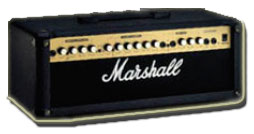Sample Settings To Get The Best Sound Out Of Your
Amplifier

Here I'll give you a few good sample settings to put on your amplifier (amp). Of course they will vary from amp to amp, but never the less, the principles are still the same. Combinations are endless when comes to setting up your amp. You can spend hours fiddling with your settings. So I've decided give you a few of my settings. These settings are my winning formula and worked for me every time. They are as follows:
Settings for playing clean alternate

Settings for controlled distortion

Settings for sharp leads

You can use these settings as a basic fundamental. Adjust your amp to the settings that suits you best. Once you have the basic sound covered, then you can work on some more new settings of your own.
With such a wide range of sound possibilities, it is clearly important that you should be able to produce the kind of sound appropriate to the kind of music you are playing. With a thorough understanding of the way your equipment works, you should be able to produce any kind of sound that you need.
![]() Settings:
Settings:
Six different but widely used amplifier settings
are shown below for you to try out for yourself. Although they won't
necessarily sound the same from one model to another, the fundamental
principals will apply to most types of valve amplifiers. As always,
though, you should spend some time experimenting for yourself until you
find settings that are best suited to your own playing and music.
![]() Neutral
Settings:
Neutral
Settings:
All of the controls are set in central position,
producing a clean sound, with little or no distortion. Such a sound would
be appropriate for straightforward rhythm or chord work in most styles of
music. You can use the master volume control to alter the volume without
changing the nature of the sound.

![]() Treble-Heavy Settings:
Treble-Heavy Settings:
Boosting the treble control
produces a brighter, cutting, ringing sound. However, it also increases
the overall volume of the sound, so the master volume needs to be reduced
to compensate. Adding treble (and a touch of mid range) may be needed to
create a flat sound in a heavily sound-obsorbent atmosphere, or when using
certain types of humbucker pickups.

![]() Bass Heavy
Settings:
Bass Heavy
Settings:
Boosting the bass control produces a deeper, fuller
sound. Again you may need to compensate by reducing the master level
volume. Bass levels vary depending on the kind of loudspeaker you use.
Smaller speakers with a limited low-frequency response can benefit from
extra bass, although too much can cause distortion.

![]() Gently
Distortion
Gently
Distortion
In valve preamplifiers, boosting the input volume will
cause a gradual distortion of the sound. As this boosts the overall
volume, the master volume will have to come down to compensate. With the
tone controls even, this usually makes a good, general lead-guitar
setting.

![]() Crunch:
Crunch:
With the input volume on high, the preamplifier
distorts. The increase in treble produces a cutting sound. This kind of
effect only really works when using a valve amplifier. This setting can
also increase feedback, whether you want it or not. This can sometimes be
controlled by setting back the treble on the guitar's control
panel.

![]() Mute
Distortion:
Mute
Distortion:
With the input volume still set so the maximum
reducing the treble and midrange creates a "muffled" sound which can
provide an extremely effective "bluesy" lead effect when played with a
valve overdrive and possibly also using the rhythm pickup.

Also keep in mind when you come to set up your amp:
|
|
Leads require a lot of
treble, middle and hardly any bass. |
|
|
Rhythm requires half-treble,
no middle and full bass. |
|
|
Distortion requires you to
adjust your settings to how you like the sound. I prefer full bass,
no middle and ¾ treble. The amount of distortion always
VARIES! |
|
About the author... "How To Play The Electric / Acoustic Guitar in Exactly 30 Days!" Learn from the best - This guy shows you how he learnt to play the guitar in exactly 30 days, and bypass guitar lessons achieving real results! Results that got him featured on channel 7 news, hits FM radio, recording studio's and live on stage to thousands. Click here to go to his site now. It's got heaps of hot tips. I highly recommend it!
|